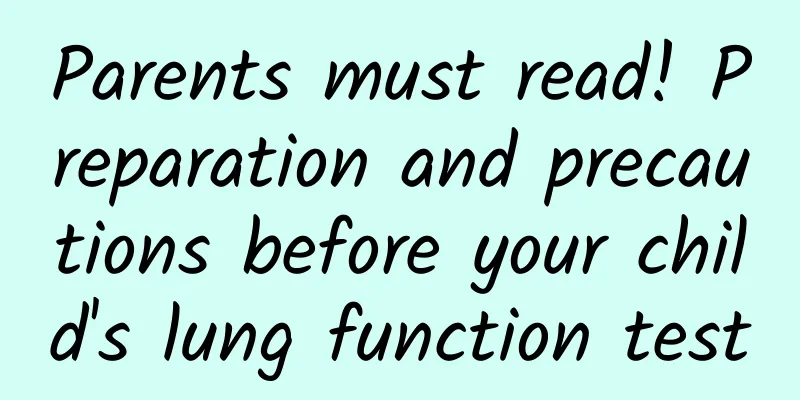Parents must read! Preparation and precautions before your child's lung function test

|
Author: Liu Chuanhe, Chief Physician, Children's Hospital Affiliated to Capital Institute of Pediatrics Reviewer: Wang Lixiang, Chief Physician, Third Medical Center, PLA General Hospital The 10th Chairman of the Science Popularization Branch of the Chinese Medical Association With the continuous advancement of medical technology, pulmonary function tests are no longer exclusive to adults. They play an increasingly important role in diagnosing children's diseases, evaluating their condition, and monitoring treatment effects. Especially for children with respiratory diseases such as asthma, regular pulmonary function tests are indispensable. However, many parents still have a superficial understanding of pulmonary function tests and know little about their importance, applicable age, and precautions before and after the test. 1. Applicable age and significance of different pulmonary function test items Pulmonary function test is a non-invasive examination method to evaluate the functional status of the respiratory system. It reflects the ventilation and gas exchange function of the lungs by measuring the changes in parameters such as gas flow and volume during breathing. From a medical perspective, in the field of pediatrics, there is no strict age limit for pulmonary function testing. Due to the particularity of the testing technology, pulmonary function tests are relatively rarely used in infants and young children. The diagnosis of asthma in infants and young children is difficult. Children in this age group are prone to bronchiolitis and various congenital diseases. Doctors usually need to conduct certain tests to make a clear diagnosis. For infants and young children over 6 months old, if asthma or other diseases that cause wheezing are highly suspected, doctors often recommend tidal breathing pulmonary function tests to conduct a comprehensive assessment of the condition. Figure 1 Original copyright image, no permission to reprint In addition, with the continuous improvement of medical technology and the in-depth research on neonatal lung function by neonatologists and respiratory specialists, more and more premature infants and children with pulmonary dysplasia have also received lung function tests. These tests help doctors understand the degree of damage to the lung function of children and provide important basis for disease evaluation, treatment and prognosis. 2. Preparation and precautions before pulmonary function test For children who need to undergo pulmonary function tests, preparation and precautions before the test are very important. First, parents should ensure that their children do not eat too much before the test to avoid discomfort during the test. At the same time, children should remain quiet before the test and avoid strenuous exercise or emotional excitement to ensure the accuracy of the test results. For children who are currently taking asthma treatment drugs, parents need to pay special attention to the use of drugs. When undergoing bronchodilator tests, children should avoid using bronchodilators in advance to avoid affecting the test results. Similarly, for children who need to undergo bronchial provocation tests, drugs that may affect the test results, such as inhaled hormones and anti-leukotriene drugs, should also be discontinued in advance. Generally speaking, for such tests, doctors will recommend that children stop taking the drug for at least 3 days before the test to exclude the effect of the drug on lung function. In addition, parents should also pay attention to their children's physical condition. If a child is suffering from a cold, especially an infectious disease, it is recommended not to conduct a lung function test temporarily to avoid aggravating the condition or affecting the health of others. Figure 2 Original copyright image, no permission to reprint Strategies for dealing with children’s lack of cooperation Patience and skill are key when facing uncooperative children. Children with poor comprehension or emotional fluctuations will have difficulty completing the examination successfully. At this time, parents, doctors and technicians should give encouragement and explanations, and through simulation demonstrations, video guidance and gamified interactions, let children understand what to do, reduce children’s fear of the test, and increase their willingness to participate. Otherwise, there is no need to force it. For children with poor motor coordination, the examination may need to be postponed until their development is slightly mature to ensure the accuracy of the data. Fortunately, children grow and change quickly. In some cases, such as tidal breathing pulmonary function, sedatives such as chloral hydrate are needed to help infants and young children fall asleep before the examination can be completed. This drug has been used clinically for many years and is widely used. It is very safe. As long as it is used correctly, there is no need to worry too much about side effects. IV. Interpretation of the results: the joint responsibility of doctors and parents The pulmonary function test report contains a wealth of information and requires professional doctors to interpret. Doctors will focus on indicators such as the forced expiratory volume in one second (FEV1), forced expiratory volume in one second (FEV1/FVC), and vital capacity (FVC) in the flow-volume curve (FV curve). These data can reveal the degree and nature of airway obstruction. For patients with chronic lung disease, changes in vital capacity are critical. However, parents do not need to get bogged down in the details of the data, as long as they understand the overall situation. If necessary, the doctor will explain the significance of the test results in detail. Although the positive results of bronchial dilation tests and provocative tests point to the possibility of asthma, they need to be comprehensively judged in combination with clinical history to exclude interference from other diseases, such as cystic fibrosis or rhinitis, in order to ensure the accuracy of the diagnosis. Pulmonary function tests are not only a diagnostic tool, but also an important means of disease monitoring. Even if asthma symptoms are under control, regular follow-up is still necessary to assess the disease status, guide medication adjustments, and prevent recurrence. In this process, parents and doctors must cooperate well to jointly protect children's respiratory health. |
<<: Airway foreign body obstruction: An emergency guide to protect your breathing
>>: Go deep into the airway and explore the "mirror" - Talk about bronchoscopy
Recommend
What should be paid attention to after puncturing the cervical cyst
A woman's uterus often develops various disea...
Do you have diarrhea after drinking milk? Experts teach you how to deal with it
Some people are confused about why they have diar...
The most effective exercise for tightening your hips after childbirth
Many mothers are troubled by the same problem, th...
What is pepper made of? Can you eat too much pepper?
Pepper powder is made by crushing the fruit of a ...
Beauty without worries: Dealing with allergies, choosing makeup and men's skin care
Author: Wu Yan, Chief Physician, Peking Universit...
Tips for girls to get rid of beards
Many people think that growing beards is unique t...
My aunt has a lot of blood clots
The importance of menstruation to women is self-e...
Gynecological inflammation occurs frequently in summer, please do not ignore these 5 points
The weather is getting hotter and hotter, not onl...
What to do if you have back pain during your seventh month of pregnancy?
Women are still very hard during the pregnancy st...
Can you get pregnant with endometriosis?
Getting pregnant and giving birth to a child of y...
After eating one plate, the man suffered acute liver failure! Many people love to eat...
A normal day Can you get hepatitis from just a me...
Gastritis occurs frequently, choosing the right stomach medicine is the first step to "saving life"
Modern people lead fast-paced lives and face high...
The new coronavirus JN.1 variant is coming? This little thing must be done well
Recently, a wave of new coronavirus infections ha...
What causes brown discharge during pregnancy?
Some women find brown vaginal discharge after the...
Why do women have cold feet?
Men and women not only have significant differenc...









